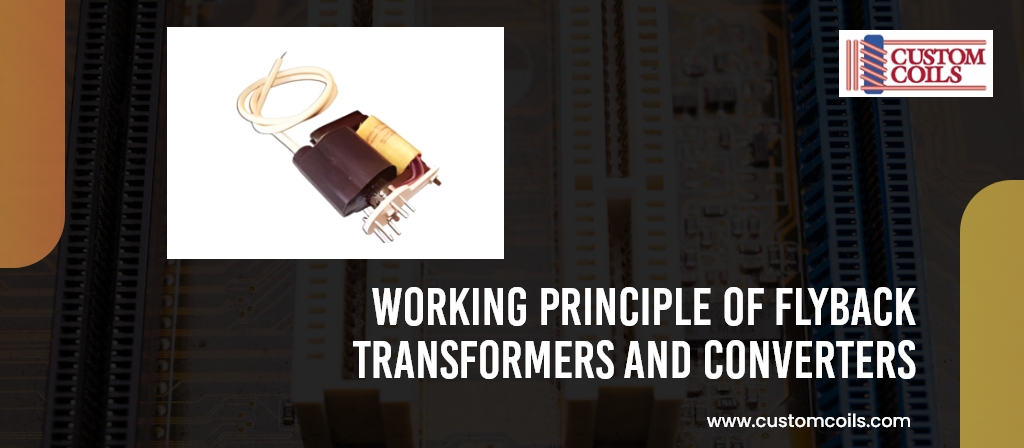A flyback transformer, or line output transformer, is essential in the electrical and electronic industries for voltage conversion to ensure seamless power supply. These transformers are renowned for handling high voltage and variable load conditions efficiently, making them crucial in both consumer electronics and industrial applications. Their unique design enables energy storage in the magnetic field during the “on” phase and delivery during the “off” phase, allowing for input voltage conversion to multiple output voltages without needing several transformers. This makes them ideal for space-constrained environments like telecommunications, medical equipment, and aerospace technology. Flyback transformers enhance the reliability and efficiency of electronic systems, driving advancements in technology and power management. This blog discusses about the working principles of flyback transformers and converters, flyback cycle, factors to consider while selecting the right transformer, and modern applications.

Working Principle of Flyback Transformers and Converters
Factor Considerations When Selecting a Right Flyback Transformer
When selecting a flyback transformer for your application, several key factors must be considered to ensure optimal performance and reliability, especially when dealing with high voltage flyback transformers. Here are some important factors to consider.
- Voltage Requirements: It’s important to accurately assess both the primary and secondary voltage requirements for your specific application. High voltage flyback transformers are particularly essential in systems requiring a significant voltage conversion, either stepping down a high input voltage or stepping up to a higher output. Managing flyback transformer voltage efficiently ensures the device can meet the energy demands without performance losses.
- Power Capacity: Determining the correct power rating is crucial based on the operational load expected. This consideration ensures that the transformer can sustain the required energy throughput without the risk of overheating or premature degradation, a common concern in high-powered applications.
- Frequency of Operation: The operational frequency has a direct impact on both the efficiency and the physical size of the transformer. High-frequency operations allow for the use of smaller components but may necessitate advanced materials to minimize energy losses through heat.
- Isolation Needs: Adequate isolation between primary and secondary circuits is vital, particularly in high voltage applications, to meet safety standards and prevent electrical hazards.
- Efficiency: Selecting a transformer with high efficiency is critical for minimizing energy losses. This is especially important in high voltage applications where inefficient energy transfer can lead to significant heat generation and reduced overall system performance.
Modern Applications of Flyback Transformer
Modern applications of flyback transformers highlight their versatility and efficiency in various sectors.
- Consumer Electronics: The compact design and efficient power conversion capabilities of flyback transformers make them ideal for use in chargers for devices like smartphones and laptops. They allow for lightweight and small-sized power adapters, crucial for modern mobile devices.
- Telecommunications: That flyback transformers are integral in telecommunications equipment comes from their ability to provide isolated and stable power, supporting infrastructure that requires multiple output voltages. This ensures reliable communication services across platforms.
- Medical Equipment: They are employed in medical devices where a precise and reliable power supply is crucial, ensuring patient safety and device accuracy. Flyback transformers are favored for their ability to maintain consistent performance under stringent medical standards.
- Industrial Automation: The use of flyback transformers in control systems within industrial settings allows for safe and efficient power management. They handle the fluctuating demands typical in industrial environments, ensuring system stability and operational continuity.
- Automotive Industry: That flyback transformers are critical in electric vehicle (EV) charging stations highlights their role in managing high voltages and providing fast charging capabilities. They support the growth of the EV market by enhancing the efficiency and safety of charging solutions.

As many industries strive towards greater sustainability and efficiency, flyback transformers emerge as main equipment in achieving these goals. Their capacity for high-voltage applications with less energy loss is particularly valuable in renewable energy systems and electric vehicle infrastructures. The adaptability of these transformers to various voltage requirements and their compact size makes them perfect for innovative applications, driving forward the sustainable technology agenda. Are you looking to optimize your power supply systems with state-of-the-art flyback transformers? Custom Coil provides innovative, high-performance transformers designed to suit a variety of applications, from automotive to telecommunications. For any queries or requirements contact their sales team today at 605.934.2460 or via email at sales@customcoils.com to learn more about the custom high voltage transformers offered by them. and get expert solutions for your critical power requirements.
